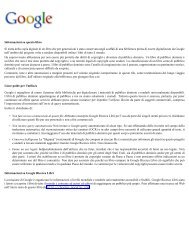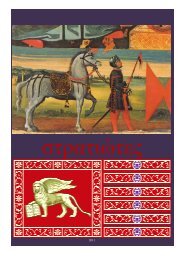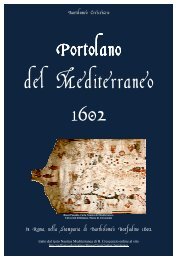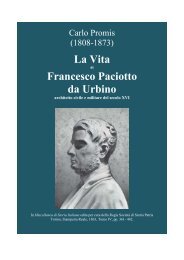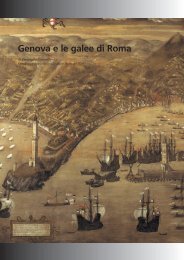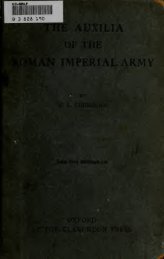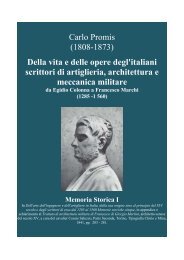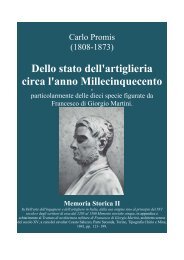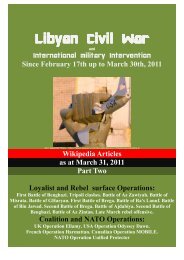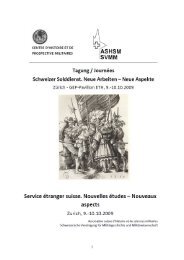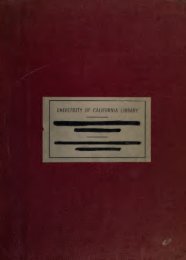United States Army Headgear 1855-1902 - Libreria Militare Ares
United States Army Headgear 1855-1902 - Libreria Militare Ares
United States Army Headgear 1855-1902 - Libreria Militare Ares
- No tags were found...
Create successful ePaper yourself
Turn your PDF publications into a flip-book with our unique Google optimized e-Paper software.
NUMBER 30 59salvage something from them, it was found that byreducing the width of the brim and reblocking thecrown, the old hats could be made to conform tothe new pattern, in appearance at least. Due totheir lack of strength and durability, however, theSecretary of War directed that they not be issuedto enlisted personnel, but rather reserved for saleto officers.^'" Issue to prisoners at Ft. Leavenworthcontinued and in 1881 a lot of 300 of those alteredwere sent to Washington for sale to District of Columbia'extra or Inauguration Police." The remainderwere apparently sold to surplus dealers.Throughout its life, this hat was worn with cordsand tassels of the pattern prescribed for the 1858hat, the majority of them from surplus 1858 patternstocks. These were priced at |.07 each."'It is obvious from its report that the board reasonedin its selection of a wool over a fur felt forthe new pattern, but no explanation can be foundin the proceedings or in allied correspondence forthe choice of the black color other than the blandstatement: "For all purposes ... it is believed thatblack is the most desirable color." On the contrary,recommendations in regard to campaign hats hadalmost universally called for a light color as opposedto dark because of the former's capacity toreflect heat and that of the latter to absorb it. Asearly as 1847 the commanding officer of the Regimentof Voltigeurs and Foot Riflemen requesteda campaign hat of gray or drab color, and throughoutthe Mexican War and the years nearly up tothe Civil War, nonregulation drab colored hatswere common in the frontier army.'"' Despite theadoption of the black <strong>1855</strong> cavalry model and the1858 pattern for the whole <strong>Army</strong>, agitation for alight colored, as opposed to black, hat continued,culminating in a strong recommendation for suchin the Woodhull Report."^' Although the very outspokencriticism of the 1872 hat was aimed primarilyat its lack of durability, much of the correspondenceincluded criticism of the black colorbecause of its tendency to absorb heat.^^'Although there was no widespread voiced reactionto the new model one way or the other for thefirst several years of its use, what criticism thatwas heard generally related to the question of color.Actually, during the period more attention seemsto have been placed on the trials of the summercork helmet which had been initiated in 1875 andwhich were to continue for some years."^ By 1880the criticism was becoming more noticeable withthe question of durability coming to the surface.Early in 1882, Major J. C. Breckinridge, an assistantinspector general, in his report following anextensive tour of frontier posts, suggested that acampaign hat of better quality than the currentmodel in either black or drab color "according toclimate" be issued. He stated further that the priceof the issue hat was too low "to warrant a goodarticle" and that the enlisted men were buying nonregulationhats whenever they could afford them.^When this report came to the attention of Brig.Gen. Rufus Ingalls, the new Quartermaster General(Gen. Meigs had retired on 6 February), hedirected the Philadelphia Depot to turn the matterover to Captain Rogers, the Military Storekeeper,who was to furnish the Quartermaster General'soffice with several sample hats of different colorsand quality. Ingalls stated that the question ofissuing drab or slate colored hats had been frequentlybrought to his attention in the past months.Rogers complied, indicating in his letter of transmittala decided preference for a change in materialand color. "The only proper substance to usein the manufacture of hats of this character," hewrote, "is a fair quality of fur felt. They will costconsiderable more to begin with than the wool hats,but a reasonable careful man can make two ofthem last through a term of enlistment, whereas hewould want five of the wool ones." He then wenton, recommending the omission of the patented"Brasher" ventilator called for in the specificationsas being too expensive and its replacement by asimple eyelet.'^' Ingalls made a selection of fur felthats and requested authority to purchase 1000 fortest, stating that they would cost about $2.00 eachin quantity as opposed to the then current |.67 forthe fur model. The Secretary of War approved andthey were procured and issued to troops in theSouthwest.'^' By mid-1883 reports from the fieldwere so overwhelmingly in favor of the drab hats,in many cases considering them superior to thecork helmets, that another 1000 were ordered withlarge ventilating holes in the side. Following receiptof additional favorable opinions, the Secretaryof War in October directed that thereafteronly drab fur felt hats were to be procured, theseto have a large ventilator replacing the "Brasher,"which was considered essentially worthless, andthat samples should be sealed and specifications



